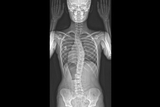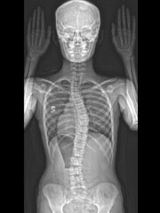
The pediatric Spine Program at Children’s Hospital of Philadelphia is known nationally and internationally for its innovations over the past two decades. Contributions to the field have included improvements in surgical technique, perioperative care, and quality, safety and value.
Key milestones in the management of spine deformities

In the early 2000s, CHOP’s spine surgeons collaborated with a local neurophysiologist to develop sophisticated multimodal neural monitoring. This led to an award-winning paper and rapid adoption worldwide of a new standard of care.
In 2007, Division Chief, John M. Flynn, MD, was the first to use image-guided navigation in pediatric spine deformity, and published studies showing the significant safety gains from this approach. Navigation is now used at most pediatric spine deformity centers, and it is becoming the national standard of care as the technology becomes more widely available.
Collaborating with anesthesia and the pain service, CHOP’s spine deformity program developed the Rapid Recovery Program (RRP), significantly reducing both postoperative pain and length of stay after scoliosis surgery. Seven years ago, the postoperative stay was five to seven days, with RRP; it is now two to three days. The RRP has been adopted by many children’s hospitals across the country.
The most recent nationally acclaimed innovation is CHOP’s Dedicated Spine Teams (DSTs). Working in collaboration with anesthesia, nursing and CHOP’s Office of Clinical Quality Improvement, Dr. Flynn led the development of DSTs in 2015. The quality, safety and value advances have been huge and include large reductions in OR time, blood loss and cost. This innovative care model has swept the nation, was presented in best paper sessions for the Pediatric Orthopaedic Society of North America (POSNA) and the Scoliosis Research Society, was quickly adopted at other pediatric spine centers, and became a source of quality points on the U.S. News & World Report survey.
Finally, a novel technique to get a free skeletal age on every child having a low radiation EOS scoliosis film won the quality, safety and value award at POSNA, and has become a popular technique in most pediatric spine centers.
Continuing to advance standards of care
CHOP Orthopaedics has also been at the forefront of reducing pediatric and adolescent opioid use after injuries and operations. The CHOP Spine Program has developed innovative ways to monitor postoperative opioid use, and with careful counseling and the rapid recovery pathway, most teenagers only need opioids for five to seven days after their spine deformity correction, which is significantly less than in past years.
Patrick Cahill, MD, has led CHOP’s effort to launch vertebral body tethering (VBT), an experimental technique to use an anterior flexible tether to control scoliosis, and a child’s remaining growth to drive some further deformity correction. While the technique has been controversial nationwide because of questionable practices at several centers, Dr. Cahill took the high road, creating the FDA-sponsored IDE trial, based at CHOP.
Success of the trial, and transparent collaboration with the FDA, led to FDA tethering device approval in 2019, likely setting the stage for wide adoption at other centers. Many clinical and basic science research projects are underway at CHOP to further refine VBT and determine optimal indications.
All these innovations in care — neural monitoring, intraoperative navigation, rapid recovery pathway, dedicated spine teams and opioid reduction efforts — and the recent launch of vertebral body tethering, are attracting families from across the region, nation and globe. Our renowned referral nurse navigator works with families to facilitate second opinions with a CHOP spine surgeon. Despite the high demand, our nurse navigator is able to get families in to see one of our spine surgery experts quickly, so that all can have access to the innovations and great quality improvements developed at CHOP over the past decade.
Featured in this article
Specialties & Programs
The pediatric Spine Program at Children’s Hospital of Philadelphia is known nationally and internationally for its innovations over the past two decades. Contributions to the field have included improvements in surgical technique, perioperative care, and quality, safety and value.
Key milestones in the management of spine deformities

In the early 2000s, CHOP’s spine surgeons collaborated with a local neurophysiologist to develop sophisticated multimodal neural monitoring. This led to an award-winning paper and rapid adoption worldwide of a new standard of care.
In 2007, Division Chief, John M. Flynn, MD, was the first to use image-guided navigation in pediatric spine deformity, and published studies showing the significant safety gains from this approach. Navigation is now used at most pediatric spine deformity centers, and it is becoming the national standard of care as the technology becomes more widely available.
Collaborating with anesthesia and the pain service, CHOP’s spine deformity program developed the Rapid Recovery Program (RRP), significantly reducing both postoperative pain and length of stay after scoliosis surgery. Seven years ago, the postoperative stay was five to seven days, with RRP; it is now two to three days. The RRP has been adopted by many children’s hospitals across the country.
The most recent nationally acclaimed innovation is CHOP’s Dedicated Spine Teams (DSTs). Working in collaboration with anesthesia, nursing and CHOP’s Office of Clinical Quality Improvement, Dr. Flynn led the development of DSTs in 2015. The quality, safety and value advances have been huge and include large reductions in OR time, blood loss and cost. This innovative care model has swept the nation, was presented in best paper sessions for the Pediatric Orthopaedic Society of North America (POSNA) and the Scoliosis Research Society, was quickly adopted at other pediatric spine centers, and became a source of quality points on the U.S. News & World Report survey.
Finally, a novel technique to get a free skeletal age on every child having a low radiation EOS scoliosis film won the quality, safety and value award at POSNA, and has become a popular technique in most pediatric spine centers.
Continuing to advance standards of care
CHOP Orthopaedics has also been at the forefront of reducing pediatric and adolescent opioid use after injuries and operations. The CHOP Spine Program has developed innovative ways to monitor postoperative opioid use, and with careful counseling and the rapid recovery pathway, most teenagers only need opioids for five to seven days after their spine deformity correction, which is significantly less than in past years.
Patrick Cahill, MD, has led CHOP’s effort to launch vertebral body tethering (VBT), an experimental technique to use an anterior flexible tether to control scoliosis, and a child’s remaining growth to drive some further deformity correction. While the technique has been controversial nationwide because of questionable practices at several centers, Dr. Cahill took the high road, creating the FDA-sponsored IDE trial, based at CHOP.
Success of the trial, and transparent collaboration with the FDA, led to FDA tethering device approval in 2019, likely setting the stage for wide adoption at other centers. Many clinical and basic science research projects are underway at CHOP to further refine VBT and determine optimal indications.
All these innovations in care — neural monitoring, intraoperative navigation, rapid recovery pathway, dedicated spine teams and opioid reduction efforts — and the recent launch of vertebral body tethering, are attracting families from across the region, nation and globe. Our renowned referral nurse navigator works with families to facilitate second opinions with a CHOP spine surgeon. Despite the high demand, our nurse navigator is able to get families in to see one of our spine surgery experts quickly, so that all can have access to the innovations and great quality improvements developed at CHOP over the past decade.
Contact us
Spine Program